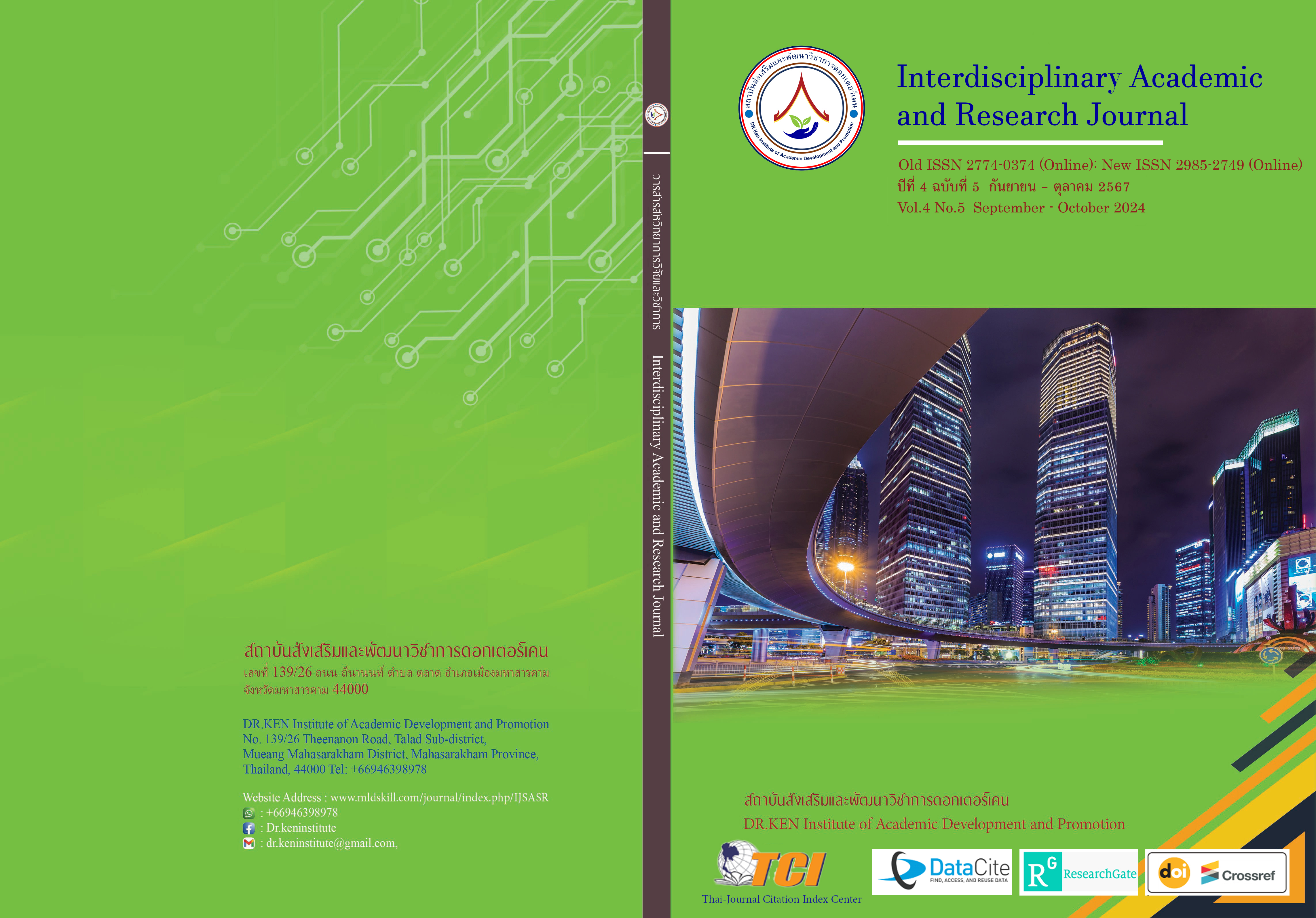The Use of Digital Technology in the Administration of the Chaiyaphum Provincial Learning Promotion Office
DOI:
https://doi.org/10.60027/iarj.2024.276339Keywords:
Use of digital technology; , Office of Learning PromotionAbstract
Background and Aims: This research aims to (1) study and compare the level of use of digital technology in the administration of the Chaiyaphum Provincial Learning Promotion Office. Separated by education level, age, and position of personnel. And (2) explore ways to develop the use of digital technology for administration in the Chaiyaphum Provincial Learning Promotion Office.
Methodology: The sample used in the research consisted of 229 personnel from educational institutions under the Chaiyaphum Provincial Learning Promotion Office, which were obtained by stratified sampling. The research tools included a questionnaire with a 5-level rating scale, with an IOC between 0.80 – 1.00 and a confidence value of 0.91. In addition, structured interviews were used to collect data. Statistics used in data analysis include frequency, percentage, mean, standard deviation, T-test, F-test, and pairwise difference test using the Scheffe method.
Results: The results of the research found that (1) the use of digital technology in administration of the Chaiyaphum Provincial Learning Promotion Office, overall, it is at a high level. And when considering each aspect, it was found that the use of digital technology in administration was at a high level in every aspect. (2) Results of comparative analysis of the use of digital technology in the administration of the Chaiyaphum Provincial Learning Promotion Office Classified by educational level found that there was no difference, while when classified by age and position It was found that there was a statistically significant difference at the 0.05 level. (3) Guidelines for using digital technology in the administration of the Chaiyaphum Provincial Learning Promotion Office It was found that it was necessary to promote and support personnel in educational institutions to receive training and knowledge development through the internet network system. Teaching and learning are organized through E-Learning, DLIT, DLTV, Zoom, Microsoft Teams, including the use of technology to develop education in collaboration with network partners, both public and private, in various formats.
Conclusion: Current and future technological changes are occurring at a very high speed compared to past changes, which has a great impact on the management of educational institutions. Therefore, educational institution administrators need to adjust their management attitudes and concepts to be up-to-date and suitable for the changing situation that has occurred. To be able to manage educational institutions effectively in this digital age.
References
กฤติภัทรกร ศิริภัทรนิธิโภคิน. (2564). การใช้เทคโนโลยีในการบริหารงานของผู้บริหารสถานศึกษาในยุควิถีใหม่สังกัดสำนักงานเขตพื้นที่การศึกษาประถมศึกษากระบี่. ศึกษาศาสตรมหาบัณฑิต สาขาวิชาการบริหารการศึกษา มหาวิทยาลัยหาดใหญ่.
เกสิณี ชิวปรีชา. (2565). การใช้เทคโนโลยีดิจิทัลแพลตฟอร์มในการบริหารสถานศึกษาระบบทวิภาคี ของวิทยาลัยเทคนิค สังกัดสถาบันการอาชีวศึกษากรุงเทพมหานคร. วารสารปรัชญาปริทรรศ์. 27(1), 50 – 58.
จีระนันท์ มูลมาตร. (2564). การใช้เทคโนโลยีสารสนเทศเพื่อการบริหารของสถานศึกษาในยุคดิจิทัล ทรานฟอร์เมชั่น. วารสารคุณภาพชีวิตกับกฎหมาย, 17(2), 21-32.
ชินวัตร เจริญนิตย์. (2566). สภาพและปัญหาทักษะการใช้เทคโนโลยีดิจิทัลในการบริหารสถานศึกษา สังกัดสำนักงานเขตพื้นที่การศึกษาประถมศึกษาอุบลราชธานี เขต 1. วารสารวิชาการมหาวิทยาลัยราชภัฏศรีสะเกษ, 17(2), 98 – 113.
ณัฐวัตร ยาท้วม. (2566). แนวทางการบริหารการศึกษาตามอัธยาศัยในยุคดิจิทัลสังกัด สำนักงานส่งเสริมการศึกษานอกระบบและการศึกษาตามอัธยาศัยจังหวัดลำพูน. วารสารการบริหารจัดการและนวัตกรรมท้องถิ่น, 5(8), 435 – 447.
ทินกร เผ่ากันทะ และกัลยารัตน์ เมธีวีรวงศ์. (2565). แนวทางการบริหารสถานศึกษาในยุคดิจิทัล. วารสารสมาคมพัฒนาวิชาชีพการบริหารการศึกษาแห่งประเทศไทย, 4(2), 37-45.
บุญชม ศรีสะอาด. (2553). การวิจัยเบื้องต้น. กรุงเทพฯ : สุวีริยาสาส์น.
ภัทรา วยาจุต. (2566). การใช้เทคโนโลยีดิจิทัลในการจัดและส่งเสริมการเรียนรู้ สำหรับครูศูนย์การศึกษานอกระบบและการศึกษาตามอัธยาศัย. วารสารสหวิทยาการมนุษยศาสตร์และสังคมศาสตร์, 6(3), 1672 – 1690.
มณีนุช ภูยังดี. (2564). สภาพปัจจุบัน สภาพที่พึงประสงค์ และแนวทางพัฒนาการใช้เทคโนโลยีดิจิทัลเพื่อการบริหารจัดการสถานศึกษาของโรงเรียนสังกัดสำนักงานเขตพื้นที่การศึกษาประถมศึกษานครพนม เขต 1. วารสารรัชต์ภาคย์ (สาขามนุษยศาสตร์และสังคมศาสตร์), 15(40), 249 – 263.
สำนักงานส่งเสริมการเรียนรู้จังหวัดชัยภูมิ. (2566). สารสนเทศเพื่อการศึกษา. ชัยภูมิ : สำนักงานส่งเสริมการเรียนรู้จังหวัดชัยภูมิ.
สุนันทิณี ชวฤทธิ์เดชา. (2566). ความสัมพันธ์ระหว่างการมีส่วนร่วมกับการบริหารงานของภาคีเครือข่ายศูนย์การศึกษานอกระบบและการศึกษาตามอัธยาศัย อำเภอป่าโมก จังหวัดอ่างทอง. วารสารสังคมศาสตร์เพื่อการพัฒนาท้องถิ่น มหาวิทยาลัยราชภัฏมหาสารคาม, 7(3), 27 – 34.
อัญชลี ธรรมะวิธีกุล. (2566). การบริหารงานศูนย์ส่งเสริมการเรียนรู้ (ฉบับปรับปรุง). กรุงเทพฯ : กรมส่งเสริมการเรียนรู้.
Krejcie, R. V., & Morgan, D. W. (1970). Determining sample size for research activities. Educational and Psychological Measurement, 30(3), 607–610.
Downloads
Published
How to Cite
Issue
Section
License
Copyright (c) 2024 Interdisciplinary Academic and Research Journal

This work is licensed under a Creative Commons Attribution-NonCommercial-NoDerivatives 4.0 International License.
Copyright on any article in the Interdisciplinary Academic and Research Journal is retained by the author(s) under the under the Creative Commons Attribution-NonCommercial-NoDerivatives 4.0 International License. Permission to use text, content, images, etc. of publication. Any user to read, download, copy, distribute, print, search, or link to the full texts of articles, crawl them for indexing, pass them as data to software, or use them for any other lawful purpose. But do not use it for commercial use or with the intent to benefit any business.
















.png)


